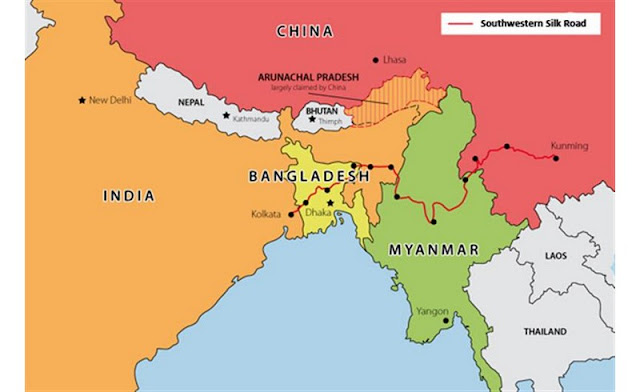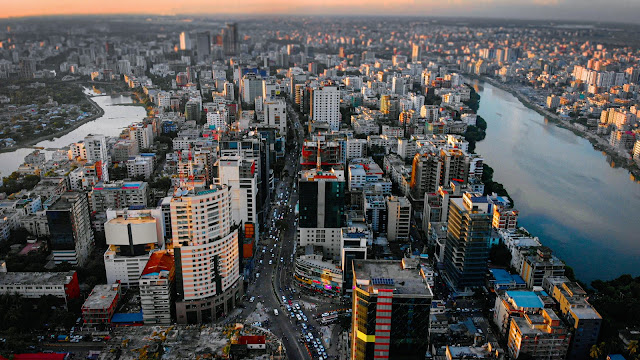Bangladesh, nestled in a crook of India’s eastern territory and Myanmar to southeast, with the Bay of Bengal to the south, is the world’s eighth most populous country with 163 million people, and has an area of 148,460 sq km/57,320 sq mi (a little bitter than Iowa). Its capital is Dhaka. Though it averages 85 m/280 ft above sea level, the plateaus to the north and west pull the average far up. 79% of Bangladesh’s area is the Ganges-Brahmaputra delta, which drains ¾ of the Himalaya Mountains’ south flank. This area—4/5 of all of Bangladesh—has a mean elevation of only 5 m/16 ft. This is why Bangladesh is known as “ground zero for climate change.”
Political map of Bangladesh region.
There are traces of stone age humans dating to 20 KYA, and copper (as opposed to bronze, due to the lack of tin which in some parts of the world was more rare than gold) age settlements 4,000 years ago. Cities and iron weapons appeared after 1000 BCE, and a series of kingdoms existed in the area, known as Bengal, for most of the next 2,000 years. After several centuries of trade with Muslims from farther west, the region was conquered by Muslims after 1200 CE. Bengal was economically very prosperous throughout most of this imperial phase, and was known as the “paradise of nations”.
Satellite image of the Ganges Delta.
The Portuguese arrived in the 1500’s and the British in the 1700’s. After the British conquest Bengal maintained its prosperous economy. When the British ceded rule in that region in 1947, the modern-day boundaries of Bangladesh were established, but what is now Bangladesh was then East Pakistan, a region partitioned off for Muslims. It gained its independence from West Pakistan—what is now simply Pakistan—in 1972.
Bangladesh has a rapidly growing economy with an also-rapidly-growing middle class. Despite that, poverty in the country remains high, as a high level of economic inequality persists. After achieving independence from Pakistan Bangladesh first turned to socialism, but a liberalized market was instituted in 1991. Its industries include textiles, pharmaceuticals, shipbuilding, steel, electronics, and others. Bangladesh also produces a substantial amount of natural gas, in its northeastern and southern regions, and is thought to have significant offshore reserves.
Dhaka, capital city.
The Ganges delta is actually the union of three rivers: the Ganges, Brahmaputra and Meghna rivers. The low-lying delta, susceptible to flooding, is mostly arable and very lush. To the northeast the land rises to mountains, Bangladesh’s tallest peak being Saka Haphong. Bangladesh is mostly tropical, with a temperate northern zone. Most of the delta is savanna, but the northeastern and eastern regions are rainier. The monsoon brings rain from June to October, and the warm winter lasts from October to April. Bangladesh’s biodiversity is prodigious, with massive mangrove forests, more than 6000 known plant species (including 5000 producing flowers), a huge variety of fruits, both deciduous and coniferous forests, and a huge range of animals including the king cobra, deer, mongooses, dolphins and the gorgeous, though endangered, Bengal tiger.
Bengal tiger.
Tomorrow: Bangladesh and climate change.
Be brave,
and be well.











No comments:
Post a Comment